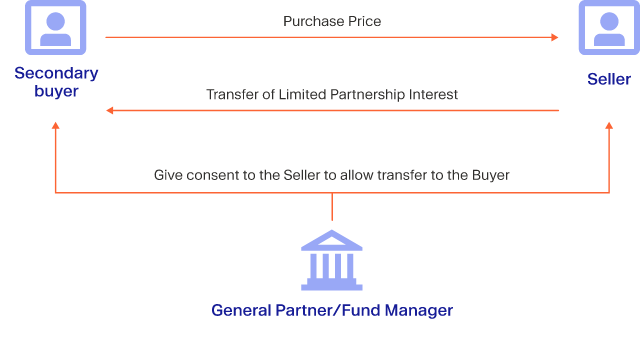The private equity secondary market refers to the buying and selling of commitments to private equity commitments during a fund’s lifetime. To avoid confusion, when making reference to both private equity secondaries and direct investments into private equity funds, these direct investments are often known as “primary” private equity.
The private equity secondary market has grown steadily since the turn of the century as the benefits have become hard to ignore. These include access to liquidity, a faster return profile and the ability to mitigate Blind Pool risk - see below for more on each of these.


This is the most common secondary transaction. It involves an existing Limited Partner that sells its assets to a secondary buyer. The buyer without prior investment in the fund then replaces the Limited Partner with all their rights and obligations.
The most popular type of GP-led transaction is the ‘continuation vehicle transaction’, taking place when a General Partner needs to extend the investment period of a fund that has reached the end of its life. Portfolio companies (or a single asset) are moved to a new fund vehicle that enables additional follow-on capacity and, hence, extended hold periods. Existing Limited Partners have the option to either ‘roll-over’ or cash out the interest to a secondary buyer. This is also known as “fund recapitalisation”.
This is the trade of directly-held ownership interest in a company from Limited Partners to an existing investor. A direct secondary transaction is an opportunity to sell stock before the entire portfolio of companies has been sold.
For sellers, secondaries can offer a valuable mechanism to better manage otherwise illiquid private equity portfolios. Selling stakes creates a stream of cash that is ready to be deployed into potentially new investment priorities - or satisfy an urgent need for capital.

For buyers, investing in a private equity fund secondary as opposed to a primary investment in a fund cuts down the time until cash is returned to Limited Partners. This will - of course - be reflected in the purchase price: the shorter the period until it starts returning capital, the more expensive (and vice versa).
“Blind Pool Risk” refers to the fact that Limited Partners commit capital to a portfolio that is yet to be constructed, creating a “blind pool” of capital. In the case of secondaries - especially those purchased late in a fund’s lifetime - investors are putting their money into companies that are already known, allowing them to analyse the performance so far and calculate the future value potential of the underlying companies.
For more on how to access the private equity secondary market, visit the Moonfare Secondary Marketplace. Though liquidity is not guaranteed, Moonfare’s semi-annual digital secondary market is a structured auction that allows investors seeking early liquidity a chance to sell their Moonfare allocations to other members.
It is important to make a distinction between the market for private equity fund secondaries (as described above) and a secondaries fund. In the case of a secondaries fund, the fund manager creates a portfolio of private equity fund secondaries, either by buying out other investors or investing capital into funds after they launch.
Investing in a secondaries fund has a number of key benefits:
Important notice: This content is for informational purposes only. Moonfare does not provide investment advice. You should not construe any information or other material provided as legal, tax, investment, financial, or other advice. If you are unsure about anything, you should seek financial advice from an authorised advisor. Past performance is not a reliable guide to future returns. Don’t invest unless you’re prepared to lose all the money you invest. Private equity is a high-risk investment and you are unlikely to be protected if something goes wrong. Subject to eligibility. Please see https://www.moonfare.com/disclaimers.